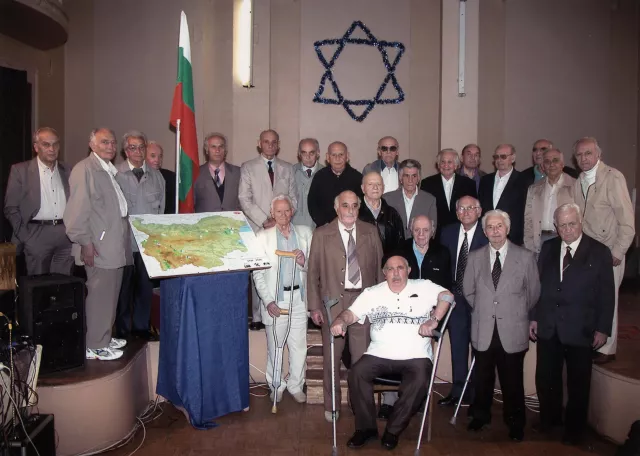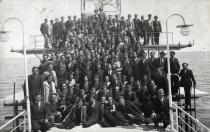David Kohen at the 60th anniversary of the liquidation of Jewish forced labor groups
This is a photo of a gathering in Plovdiv on 18th September 2004. We were celebrating the 60th anniversary of the liquidation of Jewish forced labor groups. In the photo I’m the fifth from the left in the last row. First from the right in the first row is Isak Levi. He was doing some research on Solitreo, the old alphabet of Sephardic Jews. He’s probably the only Jew in Bulgaria who still knows the Solitreo alphabet.
I have written an article on the Jewish forced labor groups. I explained there that the legal basis for the formation of such groups was embodied chiefly in the Law for the Protection of the Nation where there was a strict passage clarifying the status of the Jews as people who couldn't be summoned to service in the army, but had to serve their time as soldiers in the labor corps. They were set up in January 1942. However, this happened after insistence from the part of the German Labor Front , which declared it would cancel all its contacts with Bulgarian labor troops, if Jews were accepted as servants there, Jews weren't sent to serve in the labor corps, but to separate labor groups set up by a verdict of the Council of Ministers and attached to the Ministry of Public Buildings, Roads and Public Works.
I was in such labor groups until 1944. On 8th September 1944 we heard that the Russian army was nearing. Meanwhile I was sent to work at the office of the water management construction department in Smyadovo. I got an order to prepare a poster for the welcoming of the Russian troops. I had no political training and I wrote the first thing I thought of. So it read: 'Welcome, dear guests!' A man argued that they weren't guests, but liberators. However, what I wrote was hung as a slogan above the street. First came a reconnaissance automobile with machine-guns fixed to it to see if there were any troops nearby. A crowd of villagers flocked to the car. One of them mounted to one of its footboards and made a speech. There was also a group of women in black head-cloths, who were standing near a well crying. A Soviet officer asked why they cried and he was answered that in the well the bodies of dead anti-fascists had been thrown. We were quite excited on this day.





















